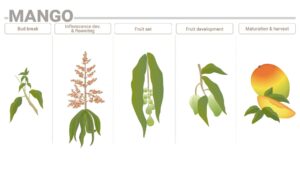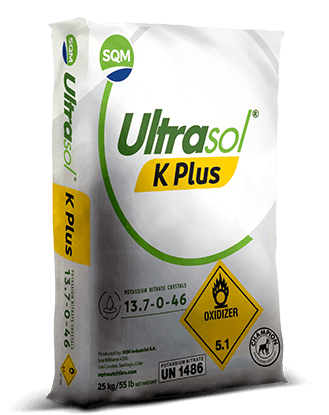Growing mango trees at ultra high density holds many advantages, one of which is the ease of inducing the trees to flower in tropical environments. Growers in Colima wish to have flowering occur in April as opposed to in October and November, when flowering normally occurs. This is because of the oversupply of fruits from the end of March until the beginning of June each year, rendering extremely low prices on the domestic, USA and Canadian markets. Successful induction requires general branch pruning of the trees just prior to Paclobutrazol soil application. Proper pruning of large trees is difficult, requiring ladders, and takes time. Ultra high density trees are spaced closer together and the height of the trees is maintained at 1,6 to 2m for optimal orchard light utilization (Figures 1 and 2). Trees of this height can be cut back without the use of ladder, and can easily be pruned according to precise instruction. Canopy spread and height growth is contained by pruning the terminal shoots back, at the time of fruit set (in non-bearing branches) and after harvest (in bearing branches). Pruning of a hectare of trees can take less than a quarter of the time required for that of a traditional orchard with trees 3 m high or higher.

Figure 1. Dr Steve Oosthuyse explaining the process of inducing “out-of-season” flowering to mango growers in the Colima region of Mexico. In this region trees are grown at Ultra High Density, trees are spaced at 3m (between rows) x 1 m (between trees in the row). The height of the trees is maintained at 1,6 to 2m rendering them “easy-to-prune”.
To induce out of season flowering, the first step of the process of inflorescence induction is to prune all of the terminal shoots back by 20 to 40 cm. This synchronises growth and reduces variation in the time of flowering commencement. Once the new shoots begin developing from beneath each heading cut, Paclubutrazol is applied to the soil around each tree trunk. Ultrasol® K spray application (potassium nitrate) is started about a month before the desired time of flowering. Foliar applications at 2,5% (w/v) Ultrasol® K each are made at 12 to 15 day intervals until inflorescence development is seen to be intense. Ethrel can be applied once the new terminal shoots become dark green to prevent an additional flush of growth prior to when flowering is desired, and this can be combined with Ultrasol® SOP (2 kg/100 L water [2% w/v], potassium sulphate).

Figure 2. The trees in an ultra high mango orchard are allowed to grow into one another in the row. This gives rise to hedge rows, which have a greater surface area than individual trees.




